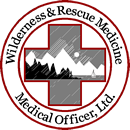Epinephrine and Anaphylaxis
A low risk treatment for a high risk problem!
©2023 Jeffrey E Isaac, PA-C
In the last newsletter, I tried to talk you out of buying an AED (cardiac defibrillator) on the grounds that it’s considerable expense is not justified by the miniscule chance that it would do you any good in a cardiac arrest at sea. I also promised to suggest some items that are worth the money and time. The epinephrine auto-injector such as the EpiPen is one of them. You are far more likely to save a life with one of these.
An epinepherine autoinjector is a spring loaded hypodermic syringe designed to inject a therapeutic dose of the drug epinephrine into a patient suffering an acute, severe, systemic allergic reaction. This life threatening medical emergency is known as “anaphylaxis”, and develops as a result of the massive release of the chemical mediator histamine into the blood stream as part of the body’s over-zealous response to a foreign substance (known as an allergen). Allergens can be almost anything; peanuts, jellyfish toxins, lobster, bee venom, perfume…you name it, someone can be allergic to it. What’s really interesting is that up to 50% of patients presenting in anaphylaxis have no previous history of allergies. It comes as a complete surprise!
Histamine, one of the main culprits in anaphylaxis, causes bronchial constriction and vaso-dilation; that is, it constricts your airways and dilates your blood vessels. If the reaction is severe enough, the blood vessel dilation results in hives, swelling, and distributive shock. The swelling in the airways, along with the bronchial constriction, causes respiratory failure or arrest. This all can happen within minutes. No time for helicopters, medical textbooks, or radio medical advice. You must act immediately.
Epinephrine (also known as adrenalin) is a bronchial dilator and a powerful vaso-constrictor. It can counter the effects of histamine within seconds of administration, saving the patient’s life. It also acts long term to stabilize the mast cells responsible for releasing the histamine. An autoinjector is a nearly idiot-proof device for injecting the correct dose of epinephrine. The needle on an EpiPen will penetrate wet suits and foul weather gear with ease. Some other products are less robust, but the result is the same. Press the business end against the patient’s thigh and hold for a few seconds while the drug is injected.
The injection is usually followed by a 911 call and an ambulance...unless there isn't one. On the water or in the backcountry we add an antihistamine and a steroid to our treatment. These drugs can work alongside the epinephrine to guard against a biphasic reaction (rebound reaction). Ceterizine is a common antihistamine and is given at 10 mg mouth. Dexamethasone (a prescription medication in the US) is given at 10 mg by mouth. You may need to administer a second or third dose of epinephrine if symptoms do not improve, or if symptoms return before the drugs become completely effective.
The Epi-pen is a single dose, single use item. You should carry at least two Epipens or an alternative device capable of delivering two doses. If you are trained and comfortable with needles and drug doses consider carrying three 1mg ampules or vials of epinephrine and three 1cc insulin syringes. You will need to draw up the right dose and inject it manually.
You will need to be trained in the recognition and treatment of anaphylaxis. It is certainly not rocket science and is included in Wilderness First Responder and Offshore Emergency Medicine® courses. To acquire the epinephrine and dexamethasone in the US, you will need a prescription from your medical practitioner. The EpiPen is over the counter in Canada, and citerizine is over the counter in the 10mg dose almost everywhere. Nevertheless, be sure that you know the side effects and contraindications for the use of dexamethasone and citirizine. No drug is entirely benign.
You will be annoyed by the price of the EpiPen, at least in the US. Fortunately, public pressure has resulted in less expensive alternatives. In the mean time, think Canada or Mexico. If you are more penurious and willing to do a little training, the ampules and syringes I've mentioned will cost you a lot less.You will also notice that the drug expires in less than 2 years. Realistically, it will last twice that long if you don’t freeze or cook it. Antihistamines and dexamethasone are pretty cheap, but without the epinephrine they are not an emergency treatment.
In my opinion, anaphylaxis recognition and treatment is required emergency training a for voyaging sailors. The whole process should take a fraction of the time you’ve devoted to learning CPR and AED, and is a lot more likely to save a life. It is exactly what we like in wilderness and marine medicine; a very low risk procedure for a very high risk problem.

